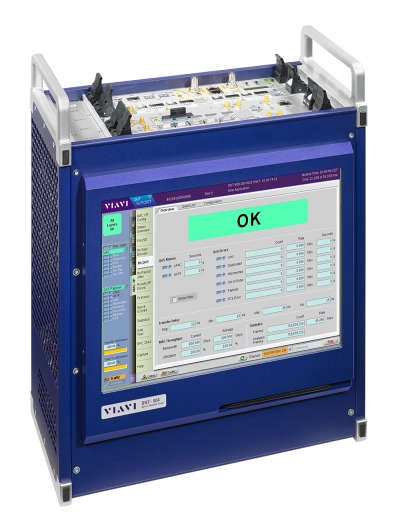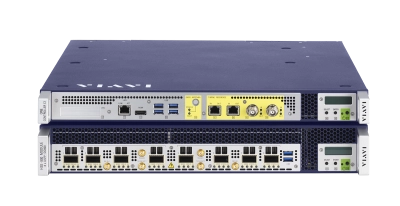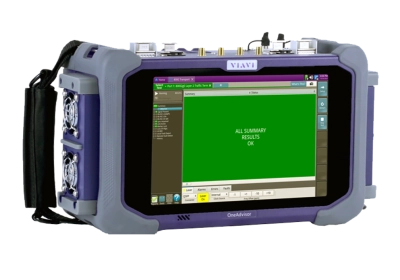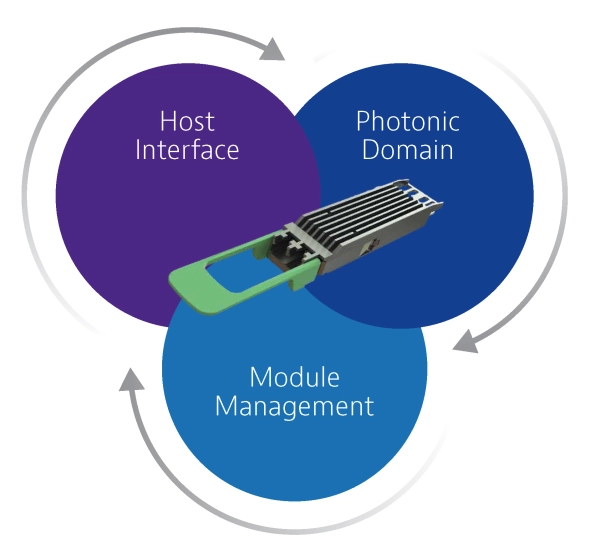800G
Test solutions for the emerging 800G ecosystem
Ever-increasing data transmission speeds and the rapid evolution of hyperscale data centers have prompted the creation of a new 800G Ethernet ecosystem. As advanced transponder technology progresses from development to full production and adoption, VIAVI enables the transition through proactive, forward-thinking test and validation solutions.
Products
-

ONT-800
Highly configurable, multi-protocol, multi-port test platform for R&D and system verification of optical...
-

ONE LabPro
High port count, multi-rate Ethernet network performance test system up to 1.6T integrating insightful Physical...
-

800G Transport Module
Provides full rate and optic coverage, in addition to OTDR and OSA support.
Testing 800G with VIAVI
By incorporating 800G test functionality within an existing suite of advanced optical network test solutions, VIAVI has become a trusted partner for developers and manufacturers as they ensure interoperability and conformance to 800G standards. This unmatched expertise is the product of decades of network testing experience coupled with ongoing IEEE and ITU-T committee participation as new standards and practices are established.
VIAVI test offerings for 800G focus on accelerated time to market for chip, transponder, and network equipment manufacturers. Advanced low layer error analysis, dynamic skew testing, and forward error correction workflows instill confidence in a new class of 800G pluggable modules. At the same time, user friendly interfaces, test automation, and versatile cooling features ensure this new plateau of Ethernet speed does not compromise test efficiency and reliability.
What is 800G?
800G is the latest generation of high-speed optical transmission used to drive high-capacity Ethernet interfaces. The addition of 800 Gigabit per second (Gbps) capability also includes options for 8 lanes ratcheted to 800 Gbps speeds, or the pairing of two 400G channels. High baud rates of 28 or even 56 Gbaud, paired with PAM-4 modulation, enable per-lane speeds of up to 112 Gbps, allowing more data than ever to be transferred.
The demand for bandwidth brought on by cloud expansion and hyperscale data centers has accelerated the development and implementation of 800G technology. Working groups dedicated to aggressive adoption timelines include the Ethernet Technology Consortium (ETC) and the 800G Pluggable Multi-Source Agreement (MSA).
How Fast is 800G?
Much like the revolutionary 400G Ethernet that preceded it, the 800G Ethernet standard stretches the boundaries of fiber optic, laser, and computing technologies by moving data transmission speeds into unprecedented territory.
- At 800 Gbps, the latest Ethernet standard approaches the level of true Terabit Ethernet (1000 Gbps), which was once thought to be physically unattainable.
- 800G speed is demonstrated through practical examples. This heightened level of performance is equivalent to 25 HD movies or games downloading in under one second.
- Higher Order Modulation is necessary to keep up with the increased data transfer rates. New 800G transceiver modulation formats can also limit range and increase susceptibility to noise.
- Increased Baud rates, the use of Nyquist digital subcarriers, and probabilistic shaping to improve signal-to-noise SNR ratios are among the advancements enabling this impressive speed benchmark to be set.
- Cellular technology creates a larger, faster canvas for developers to explore with each new generation. By contrast, Ethernet speeds have engaged in an ongoing game of catch-up, as demand for hyperscale computing services grows exponentially. This makes 1.6 Terabit (1.6T) Ethernet a viable possibility in the not-so-distant future.
800G Multi-Source Agreement
The 800G Pluggable MSA (multi-source agreement) working group was founded in September of 2019. The name “multi-source” is based on the diverse consortium of data center operators, equipment vendors, optical module developers, and electronic component manufacturers. This cross-functional group has joined forces to accelerate network adoption, create a robust ecosystem, and improve industry collaboration.
The 800G MSA is focused on optimizing interconnect scenarios for large data center networks. This includes standardizing and documenting interface specifications for new pluggable modules. The MSA issued its first pluggable specification, the PSM8, in 2020.
This first short-range (100 meter) pluggable 800G optical transceiver doubled the capacity of existing quad small form-factor, double density (QSFP-DD) modules while repurposing the components of existing 400G modules. Leveraging existing technology fosters rapid adoption and minimizes the need for data center hardware upgrades.
800G Form Factors
MSAs specify the geometry and form factor of many electrical interfaces. In the case of 800G Ethernet, this includes pluggable optics modules (POMs) designed to facilitate the conversion between electrical and optical (light) signals. Backward compatibility, low cost, and efficient power consumption attributes contribute to the ongoing popularity of these products.
800G pluggables borrow from the technology developed for 400G while pushing the envelope further. A host-to-module interface running at 100G+ lane speeds and complex integrated photonics enable improved performance and reliability. These enhancements also introduce new testing, troubleshooting, and validation challenges throughout the product lifecycle.
- QSFP-DD 800
800G QSFP DD (Double Density) pluggable optics modules support 8 high-speed lanes running at 100Gb+/sec. QSFP-DD 800 modules are backward compatible with previous QSFP-DD and QSFP connectors/cages, making implementation easier. This new pluggable type also incorporates improved thermal and EMI performance. - QSFP112
The QSFP112 is a 400G capable “quad small form factor pluggable” carrying 112 Gbps over each lane. Also based on legacy QSFP technology, the QSFP112 utilizes a 0.6mm pin pitch design that produces outstanding signal integrity and reliability across the link. Systems designed for the 800G capable QSFP-DD 800 are also compatible with the QSFP112. OSFP 800G
Optical small form factor pluggables (OSFPs) include integrated heatsinks and are backward compatible with 400G modules but not with QSFP interfaces. The OSFP 800G specification was released in June of 2021 and includes support for dual 400G and octal (8)100G configurations. The physical design of OSFP modules provides high growth potential, making them an attractive option for fast-growing hyperscale applications.
400G / 800G Transponders and Transceivers
Hyperscale data centers and breakthrough technologies like Machine Learning and Artificial Intelligence (AI) will ensure the demand for faster Ethernet speed continues. Even as 400G hardware is being deployed for the first time, data centers are planning for the imminent arrival of the 800G network. The market for 400G is expected to peak in 2023, followed by a steady ramp-up and transition to the 800G optical transceiver in the ensuing years.
- Transponders and Muxponders are network elements that convert incoming (often optical) client signals like 100GE, 400GE or future 800GE signals into high-speed line rate signals that typically use single wavelength coherent transmission with complex modulation formats like DP-16QAM (Dual Polarization 16 Quadrature Amplitude Modulation).
- Pluggable Transceivers are used to convert an electrical signal (in case of 100G and above, typically multi-lane and PAM-4 modulated) into an optical client signal transmitted on multiple optical fibres or wavelengths.
- Bit Error Rate Testing (BERT) is a valuable 800G test metric that quantifies how well the input signal is being converted. The complexity introduced by PAM-4 modulation ensures that these links will always have some level of transmission errors.
- The VIAVI ONT family of optical network test solutions supports advanced BERT testing for all 800G QSFP-DD and OSFP transponders along with forward error correction (FEC) validation and stress testing. These tests provide indicators of the overall transmission quality of the data path.
- Control Path Testing ensures the transponder performs switch overs between modes accurately and repeatably. This testing also verifies a transponder is conforming to the Common Management Interface Specification (CMIS).
- Cooling is an important consideration during transponder test and validation, particularly for digital coherent optical modules (DCOs) that rely on the card cage assembly heatsink. The advanced temperature control features of the VIAVI ONT-800G family allow high-power transponders to be plugged into the ONT device and cooled effectively during testing.
- 800G DR8 is a unique category of 800G optical transceiver characterized by 8 lanes of 112 Gbps traffic, producing an aggregate of over 850 Gbps. Despite power consumption of < 16W, DR8 range can extend up to 2 km. A broad operating temperature band from 0°C - 70°C supports all data center operating conditions.
800G Testing
The new 800G Ethernet ecosystem has led to both challenges and opportunities for testing and validation. High baud rates, integrated signals, and cutting-edge photonics have made the test strategies of the past inadequate and spawned a new suite of VIAVI test solutions to help customers:
- Develop new pluggable modules efficiently by testing the electrical, module management, and photonics systems together in an orchestrated manner. IC development is also enhanced through the use of real-world signals rather than unframed PRBS.
- Deploy new transponders with confidence by leveraging VIAVI ONT 800G modules for performance testing, ecosystem interoperability, Ethernet traffic generation, and reliability testing.
- Validate transponder hardware performance, alarm functionality, forward error correction (FEC) compliance, and LOS recovery. Test products scalable to 800G provide a reliable platform for system verification testing (SVT) and production testing.
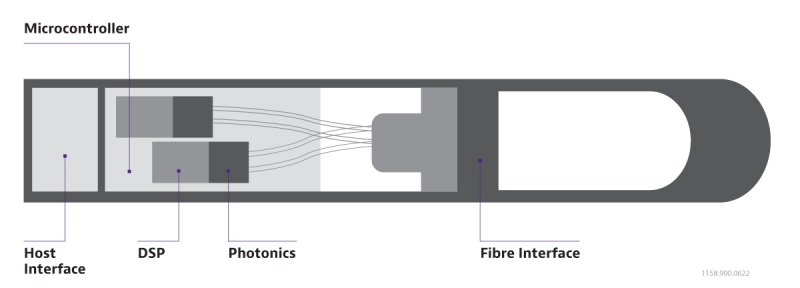
800G Testing Tools
- The VIAVI ONT 800G FLEX XPM module is the industry’s first integrated test solution with a native 800G interface based on 100G electrical lane speed. This module supports multiple pluggable form factors including the OSFP 800G and 800G QSFP DD. A comprehensive list of test capabilities includes advanced error analysis, unframed BERT, Dynamic Skew, and FEC stress testing.
- The ONT 800G FLEX V2 module, along with the ONT DCO and Ethernet modules, provides automated optical transport test features through a 2 x 400G interface. Each module is designed to ensure reliable performance and interoperability while providing unique test characteristics that accelerate production validation.
- The ONT-800 Optical Network Tester is a rack-mountable, high-performance mainframe that establishes a sturdy foundation for the ONT family of swappable test modules. The ONT-800 has a high port density, an intuitive, user-friendly GUI, and advanced cooling features adapted for high-power 800G transceiver testing.
White Papers & Books
Support at Every Step
We provide support, services, comprehensive training and the resources you need. It’s all part of what we do to maximize the value of your VIAVI investment.
Ask an Expert
Contact us for more information or to receive a price quote. We have the experts to give you the right answer on any of your questions.
